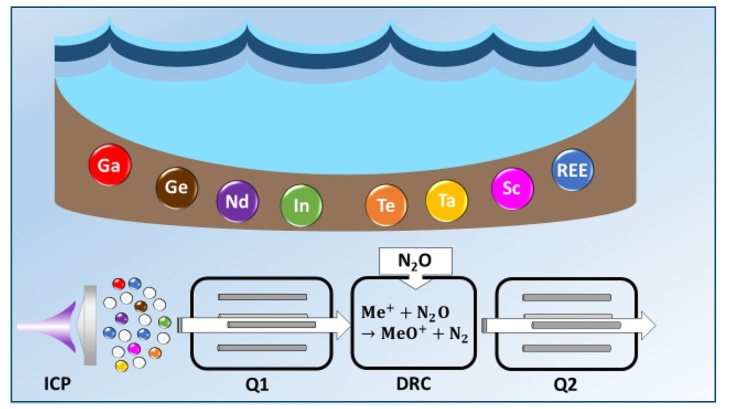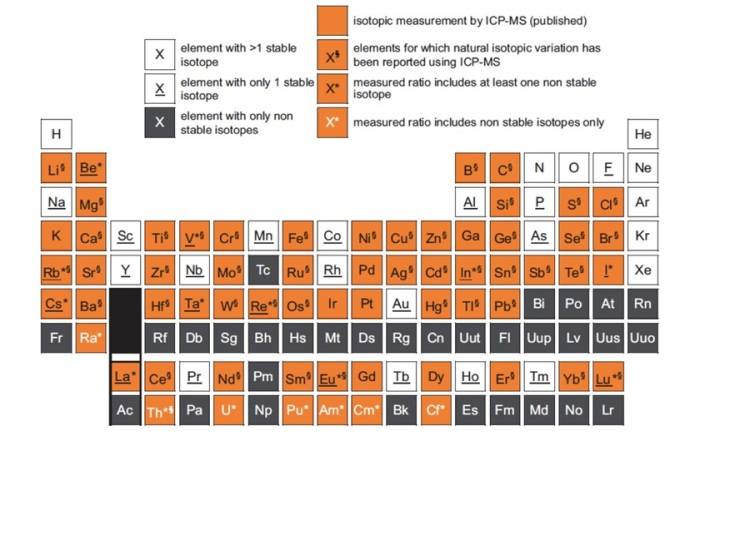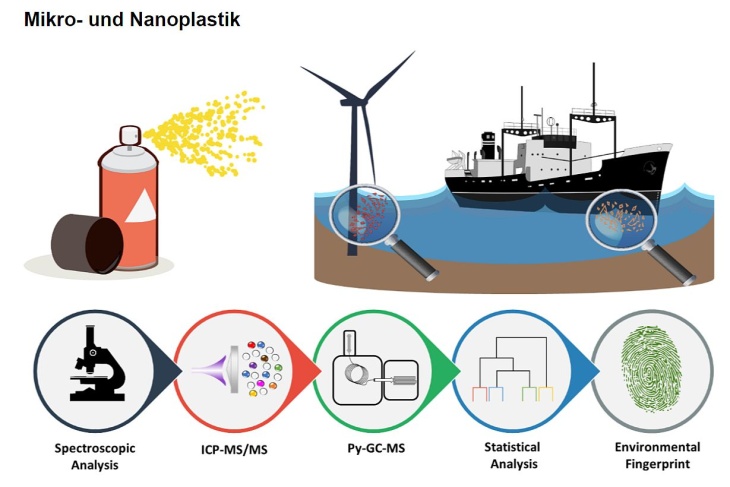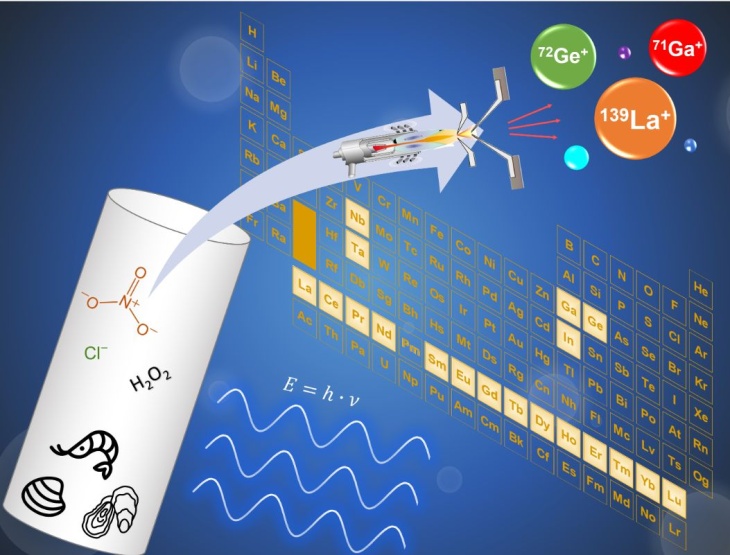Research Topics
Origin, transport and fate of inorganic and particulate pollutants
Inorganic and novel particulate pollutants pose a persistent threat to many coastal ecosystems. This is caused in particular by their inherent toxicity, their non-degradability and the large number of possible sources. In addition to the "traditional" inorganic pollutants (e.g. heavy metals), new inorganic substances are increasingly being introduced into the environment, and little is known about their general effects as well as cumulative effects with other substances. Using modern chemical-analytical methods, we investigate the occurrence, transport, fate and effects of inorganic and novel particulate pollutants in the land-river-sea continuum and in coastal regions, thus contributing to the overall understanding of the global coastal system.

Graphic from Klein, O. et al. (2021). Improved determination of technologically critical elements in sediment digests by ICP-MS/MS using N2O as a reaction gas. JAAS. https://doi.org/10.1039/D1JA00088H
With the help of modern chemical-analytical methods, which are continuously being developed, we investigate elements and their various toxicologically relevant chemical forms (species) as well as the isotopy of selected elements of the periodic table, which provide important information on the processes taking place in the environmental compartments under investigation. In addition to the classic inorganic pollutants (e.g. heavy metals), we are primarily investigating rare elements, also known as technology-critical elements (TCEs), which, due to their rapidly increasing use in current key technologies in the fields of mobility, information technology and sustainable energy generation, can be increasingly released into the environment in conjunction with a lack of recycling approaches. A current application focus is on the investigation of the chemical footprint and associated unintended side effects resulting from the ongoing expansion of offshore wind energy production in the North Sea and how the chemical stressors released in the process may affect future "multi-use scenarios", food webs and human health.
The data collected and methods developed will be incorporated into the Coastal Pollution Toolbox (CPT) of the Institute of Coastal Environmental Chemistry. They form the basis for the development of future recommendations for action to sustainably reduce emissions of the substances under consideration and the expansion of the chemical transport models operated at the institute to include new socially relevant pollutant classes. With our expertise, we also contribute to various centre-wide lighthouse projects and thus contribute to the overall understanding of the global coastal system, to the investigation of the carbon cycle and new decarbonization approaches as well as to the understanding of the degradation behaviour and interaction of new metal-based implant materials with biological tissues.

Graphic from T. Prohaska, J. Irrgeher, A. ZItek and N. Jakubowski, eds. (2015). Sector Field Mass Spectrometry for Elemental and Isotopic Analysis, Royal Society of Chemistry, Cambridge
Since its implementation in the early 1990s, the analysis of ‘non-traditional’ isotopic systems via MC ICP-MS (multicollector inductively coupled plasma mass spectrometry) has developed as promising and powerful technique. MC ICP-MS impresses because of the analytical ease mainly due to reduced sample preparation required and high sample throughput as well as its capabilities to ionize a very broad set of elements of the periodic table (click on figure to enlarge). Almost all elements of the PSE can be analyzed and thus the fields of application of MC ICP-MS range broadly.
The method can be used to discriminate between natural sources (e.g. from geogenic variability) and anthropogenic sources (e.g. from mining or industry) of an element in different environmental compartments and to deduce the relative contributions of the sources. Additionally, artificially induced changes of the isotopic composition by introduction of an enriched tracer can also be investigated.
At Hereon, isotope research focuses on developing scientific tracer tools based on highly precise isotope ratios assessed in marine compartments by MC ICP-MS. A combination of different isotopic systems (e.g. Sr, Pb, Nd, Mo) is applied for the spatially structured description and evaluation of pollutants and nutrients in the German Wadden Sea including the tracing of sediments from river systems.

Graphic from Hildebrandt, L. et al. (2024). An analytical strategy for challenging members of the microplastic family: Particles from anti-corrosion coatings. J. Hazard. Mat., 470 (January), 134173. https://doi.org/10.1016/j.jhazmat.2024.134173
Microplastics (MP) can now be found in all regions and environmental compartments of the world ranging from highly populated coastal regions up to remote regions such as the Arctic and Antarctic.The share of particles from ship coatings and offshore wind corrosion protection have been overlooked/underestimated in the existing literature as well as the role of chemical leaching from those particles. Our recent research is focused in particular on the study of sources, transport and sinks of MP and coating particles in the aquatic environment, and their role as sources and transport vector for pollutants. Here our focus is on toxicological relevant trace metals and their species that could enter the aquatic environment via leaching from MPs since different metals are frequently used as additives in plastic production.
Therefore, we develop and apply an innovative analytical toolbox to allow the accurate and traceable analysis of MP and coating particles and related chemicals in different environmental compartments. This includes innovative tools for unbiased particle sampling, sample processing, polymer analysis and number-based quantification as well as data processing tools, target analysis of chemical leaching and chemical sorption/desorption under environmental conditions, chemical imaging of pollution loads and their distribution.

Grafic from Wippermann, D. et al. (2023). Determination of technology-critical elements in seafood reference materials by inductively coupled plasma-tandem mass spectrometry. ABC, 0123456789. https://doi.org/10.1007/s00216-023-05081-z
Pollutants can affect the living environment at different levels. The analysis of chemical effects on the biotic environment and other biological systems (e.g. humans) is an important tool for comprehensive pollutant evaluation and risk assessment. In this context, mussels, for example, are used as indicator organisms to investigate pollutant uptake and distribution or to record possible pollutant effects using established physiological indices or biochemical parameters. Appropriate infrastructure is available in Cuxhaven and on Heligoland to carry out the relevant investigations.
